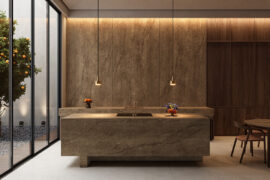When your physical environment has been destroyed, comfort – physical and, importantly, psychological – comes down to the provision of some basic building components. Sadly, they are not always present in disaster-relief situations.
A lockable door. It’s such a basic component of our built environment that its significance can be easily overlooked. But it’s one thing that many shelters for disaster relief don’t have. “When you don’t have a home anymore, the notion of a locking door becomes very important. It’s a fundamental element of architecture,” says Yann Follain, Managing Director and Head of Design at WY-TO. He adds that for women and children, it is particularly critical given the gender-based assault and child trafficking issues that are reported in disaster-relief environments.
The WY-TO team was alarmed by their discovery that 42.9 per cent of the world’s natural disasters occur in the Asia Pacific region. In response, WY-TO linked up with engineering firm Pod Structures and developed the Living Shelter – a concept for a prefabricated tilt-up structure that could be transported flat-packed to disaster areas (in preference to non-secure tents) to cater to the immediate emergency and transitional phases of recovery. A prototype has already been built. The composition of the shelter is such that as a location’s redevelopment phase progresses, parts of the structure could be dismantled and used for the creation of new permanent built forms.
“When you have peace of mind, you can think for tomorrow – how can I rebuild my life?” says Samuel Vedanaigam, the founder and CEO of Pod Structures. When you are more at ease in psychological terms, you’re in a better position to help others, he suggests. Says Follain, “When we design for normal living conditions, a lot of elements are ‘givens’ – we make them part of the design without thinking. But when you’re in a disaster situation and you don’t have anything, those elements are crucial. We must ask, what are the minimum needs? A door, a lock, a bed, a shelf, a roof, power to charge things, somewhere to cook, a light at night, and water to wash. You need all those elements to recover.”
In 2015, 85 per cent of people displaced by sudden-onset (weather-related) disasters were in South and East Asia reports the UNHCR (the UN refugee agency). So the development of solutions tailored to this region should be front of mind for those engaged in humanitarian efforts. The suitability of other shelter designs, such as IKEA’s award-winning Better Shelter (developed with Better Shelter and the UNHCR), to the tropical climate is questionable however, Living Shelter was designed for the warm and humid context of South East Asia. Referencing the raised and naturally ventilated vernacular kampung house form, the Living Shelter offers cross ventilation with mosquito netting over permanent openings beneath roof overhangs. And in the kampung house tradition, it contains a space that can be used in multiple ways.
The Living Shelter prototype was exhibited in Italy last year as part of the Venice Biennale of Architecture. The response, says Follain, was positive. “People were asking us if it could be deployed in Europe,” he recalls (to cater to the expanding refugee population there). “I said ‘no’ because it’s not yet optimised for that climate. In a colder environment you would have to replace the mosquito nets and insulate it.”
The structural sections designed for Living Shelter have already been patented, and the next stage for its development is to optimise the design and reduce its weight.
This article originally appeared in CUBES issue #86.
INDESIGN is on instagram
Follow @indesignlive
A searchable and comprehensive guide for specifying leading products and their suppliers
Keep up to date with the latest and greatest from our industry BFF's!

Rising above the new Sydney Metro Gadigal Station on Pitt Street, Investa’s Parkline Place is redefining the office property aesthetic.

London-based design duo Raw Edges have joined forces with Established & Sons and Tongue & Groove to introduce Wall to Wall – a hand-stained, “living collection” that transforms parquet flooring into a canvas of colour, pattern, and possibility.

For Aidan Mawhinney, the secret ingredient to Living Edge’s success “comes down to people, product and place.” As the brand celebrates a significant 25-year milestone, it’s that commitment to authentic, sustainable design – and the people behind it all – that continues to anchor its legacy.
The internet never sleeps! Here's the stuff you might have missed

With Steelcase having reopened its refreshed WorkLife Showroom in Singapore this year, we spoke to Navedita Shergill about some key workplace macro shifts identified in their research.

Cosentino introduces Éclos®, a new mineral surface brand featuring zero crystalline silica, high recycled content and Inlayr® technology that brings 3D layered realism to design.